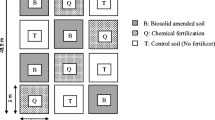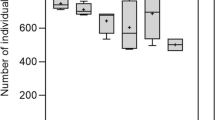Abstract
Soil degraded by coal mining activities can be remediated by amendment with agro-industrial organic sludge. However, the environmental impacts associated with this management practice must be properly addressed. In this context, the objective of this study was to evaluate the eco(geno)toxicity of a fresh and a stabilized sludge before use in a laboratory soil remediation test. Chemical analysis of the complex mixtures (degraded soil, fresh sludge, and stabilized sludge) was carried out, as well as a battery of eco(geno)toxicity tests on microbiological enzymes (fluorescein hydrolysis), earthworms, and higher plants (including Vicia faba genotoxicity test), according to published methodologies. The results of these tests showed that fresh sludge was more toxic than sludge stabilized over 6 months toward earthworms and higher plants (lettuce, corn, and wild cabbage), while phyto(geno)toxicity tests with V. faba indicated the same genotoxicity levels for the two types of sludge. In the soil remediation simulation using different mixtures of degraded soil and stabilized sludge, the proportions of 50:50 % (dry weight basis) provided the lowest phyto(geno)toxicity effects and this mixture can be used for the revegetation of the contaminated site.
Similar content being viewed by others
References
ABNT (2004) Resíduos Sólidos e Teste de Lixiviação. Associação Brasileira de Normas Técnicas. NBR 10005. Rio de Janeiro, RJ, Brazil.
Adani F, Tambone F (2005) Long-term effect of sewage sludge application on soil humic acid. Chemosphere 60:1214–1221
Adema DMM, Henzen L (1989) A comparison of plant toxicities of some industrial chemicals in soil culture and soilless culture. Ecotoxicol Environ Saf 18:219–229
Alvarenga P, Palma P, Gonçalves AP, Baião N, Fernandes RM, de Varennes A, Vallini G, Duarte E, Cunha-Queda AC (2008) Assessment of chemical, biochemical and ecotoxicological aspects in a mine soil amended with sludge of either urban or industrial origin. Chemosphere 72:1774–1781
APHA, AWWA, WPCF (1995) Standard methods for the examination of water and wastewater. American Public Health Association, American Water Works Association and Water Pollution Control Federation, 19th ed., Section 8220, Washington, DC.
Brinton WF (1998) Volatile organic acids in compost: production and odorant aspects. Compost Sci Util 4:75–82
Brinton WF, Evans E (2002) Plant performance in relation to oxygen depletion, co2- rate and volatile fatty acids in container media composts of varying maturity. In: Insam H, Riddels N, Klammer S (eds) Microbiology of Composting. Springer, Berlin
CEC (1991) Council Directive 91/689/EEC of 12 December 1991 on hazardous waste. Commission of the European Communities. Off. J. Eur. Communities L377/20
Chiochetta CG, Radetski MR, Corrêa AXR, Tischer V, Tiepo EN, Radetski CM (2013) Abandoned coal mining sites: using ecotoxicological tests to support an industrial organic sludge amendment. Environ Sci Pollut Res 20:7656–7665
Chiochetta CG, Goetten LC, Almeida SM, Quaranta G, Cotelle S, Radetski CM (2014) Leachates from solid wastes: chemical and eco(geno)toxicological differences between leachates obtained from fresh and stabilized industrial organic sludge. Environ Sci Pollut Res 21:1090–1098
Corriea-Guerrero C, de Brito JC, Lapa N, Oliveira JFS (1995) Reuse of industrial orange waste as organic fertilizer. Bioresour Technol 53:43–51
Düring R-A, Gäth S (2002) Utilization of municipal organic wastes in agriculture: where do we stand, where will we go? J Plant Nutr 165:544–556
EMBRAPA (1999) Manual de análises químicas de solos, plantas e fertilizantes. Empresa Brasileira de Pesquisa Agropecuária, Brasília DF
Guerrero C, Gomez I, Moral P, Mataix-Solera J, Mataix-Beneyto J, Hernandez T (2001) Reclamation of a burned forest soil with municipal waste compost: macronutrient dynamic and improved vegetation cover recovery. Bioresour Technol 76:221–227
Huguier P, Manier N, Chabot L, Bauda P, Pandard P (2015) Ecotoxicological assessment of organic wastes spread on land: Towards a proposal of a suitable test battery. Ecotoxicol Environ Saf 113:103–111
Iannotti DA, Grebus ME, Toth BL, Madden LV, Hoitink HAJ (1994) Oxygen respirometry to assess stability and maturity of composted municipal solid waste. J Environ Qual 23:1177–1187
International Standard Organization (2013) Soil Quality—Assessment of Genotoxic Effects on Higher Plants—Vicia faba Micronucleus Test, 29200. ISO/WS, Geneva
International Standard Organization (1993) Soil quality and effects of pollutants on earthworms (Eisenia foetida) Part 1. Determination of acute toxicity using artificial soil substrate. ISO 11268-1. Geneva, Switzerland.
International Standard Organization (1995) Soil quality and determination of the effects of chemicals added to the soil on emergence and growth of higher plants. ISO/CD 11269-2. Geneva, Switzerland.
Juwarkar AA, Jambhulkar HP (2008) Phytoremediation of coal mine spoil dump through integrated biotechnological approach. Bioresour Technol 99:4732–4741
Kapanen A, Itävaara M (2001) Ecotoxicity tests for compost applications. Ecotoxicol Environ Saf 49:1–16
Kosson DS, van der Sloot HA, Sanchez F, Garrabrants AC (2002) An integrated framework for evaluating leaching in waste management and utilization of secondary materials. Environ Eng Sci 19:159–204
Kumar GP, Yadav SK, Thawle PR, Singh SK, Juwarkar AA (2008) Growth of Jatropha curcas on metal contaminated soil amended with industrial wastes and Azotobacter—a greenhouse study. Bioresour Technol 99:2078–2082
Lattuada RM, Menezes CTB, Pavei PT, Peralba MCR, Dos Santos JHZ (2009) Determination of metals by total reflection X-ray fluorescence and evaluation of toxicity of a river impacted by coal mining in the south of Brazil. J Hazard Mater 163:531–537
Nancucheo I, Johnson DB (2011) Significance of microbial communities and interactions in safeguarding reactive mine tailings by ecological engineering. Appl Environ Microbiol 77:8201–8208
Pognani M, D’Imporzano G, Scaglia B, Adani F (2009) Substituting energy crops with organic fraction of municipal solid waste for biogas production at farm level: a full-scale plant study. Process Biochem 44:817–821
Ramírez WA, Domene X, Ortiz O, Alcañiz JM (2008) Toxic effects of digested, composted and thermally-dried sewage sludge on three plants. Bioresour Technol 99:7168–7175
Ratsch HC (1983) Interlaboratory root elongation testing of toxic substances on selected plant species. EPA 600/S3-83-051. Technical Report. U.S. Environmental Protection Agency, Environmental Research Laboratory, Corvallis.
Rosa EVC, Giuradelli TM, Corrêa AXR, Rörig LR, Schwingel PR, Resgalla C Jr, Radetski CM (2007) Ecotoxicological evaluation of the short term effects of fresh and stabilized textile sludge before application in forest soil restoration. Environ Pollut 146:463–469
Santa Catarina State (2004) Secretaria de estado do desenvolvimento urbano e meio ambiente, diretoria de recursos naturais e gestão ambiental, gerência de recursos minerais. Convênio 024/99 Relatório Parcial, Florianópolis (SC), Brazil.
Schnürer J, Rosswall T (1982) Fluorescein diacetate hydrolysis as a measure of total microbial activity in soil and litter. Appl Environ Microbiol 6:1256–1261
USEPA (1996) Semivolatile organic compounds by gas chromatography/mass spectrometry (CG/MS). On CD: Test method for evaluation solid waste physical/chemical methods, SW-846method 8270C. Laboratory manual. Vol I-B Environmental Protection Agency, Washington, D.C.
USGPO (2003) Title 40 Code of Federal Regulations (annual edition)—Protection of Environment, U.S. Government Printing Office, July 1, Washington (available at http://www.gpo.gov/fdsys/pkg/CFR-2003-title40-vol1/content-detail.html). Accessed 13 Feb 2014
Van Gestel CAM, Van der Waarde JJ, Derksen JGM, Van der Hoek EE, Veul MFXW, Bouwens S, Rusch B, Kronenburg R, Stokman GNM (2001) The use of acute and chronic bioassays to determine the ecological risk and bioremediation efficiency of oil-polluted soils. Environ Toxicol Chem 20:1438–1449
Vangronsveld J, Herzig R, Weyens N, Boulet J, Adriaensen K, Ruttens A, Thewys T, Vassilev A, Meers E, Nehnevajova E (2009) Phytoremediation of contaminated soils and groundwater: lessons from the field. Environ Sci Pollut Res 16:765–794
Wang H, Brown SL, Magesan GN, Slade AH, Quintern M, Clinton PW, Payn TW (2008) Technological options for the management of biosolids. Environ Sci Pollut Res 15:308–317
Acknowledgments
This work was financed by CNPq-Brazilian National Council for Scientific and Technological Development (Edital 44/2008-Processo 575389/2008-7). C.M. Radetski gratefully acknowledges the grants awarded by CNPq-(Grant N# 302798/2013-7).
Author information
Authors and Affiliations
Corresponding author
Additional information
Responsible editor: Hailong Wang
Rights and permissions
About this article
Cite this article
Chiochetta, C.G., Cotelle, S., Masfaraud, JF. et al. Use of agro-industrial organic sludge amendment to remediate degraded soil: chemical and eco(geno)toxicological differences between fresh and stabilized sludge and establishment of application rates. Environ Sci Pollut Res 23, 3018–3025 (2016). https://doi.org/10.1007/s11356-015-5310-0
Received:
Accepted:
Published:
Issue Date:
DOI: https://doi.org/10.1007/s11356-015-5310-0




